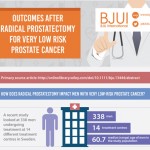Editorial: Management Dilemmas in Low-Risk Prostate Cancer
Prostate cancer is the most commonly diagnosed solid organ tumour and the second leading cause of cancer death in men in the USA. The exact path of these tumours from inception to metastasis is unclear; the same can also be said for those tumours that remain indolent. The varying genetic signatures of these tumours is the underlying determinant of the outcomes of these cancers and therein lies the key to selecting patients that do and do not need treatment for their prostate cancers. Most low-risk tumours are relatively indolent; however, some low-risk tumours have the potential to metastasise and cause mortality. The problem is that currently we do not have the ability to accurately and confidently determine the tumour’s individual risk profiles.
In the recent LAPPRO trial (LAParoscopic Prostatectomy Robot Open – a randomised, open trial of radical prostatectomy (RP) with or without lymph node dissection as part of a prospective, non-randomised, open trial comparing robot-assisted laparoscopic and open RP), the authors reported the RP results of patients with very-low-risk prostate cancer in a population-based study from Sweden compiling the results of open and laparoscopic RP over 14 centres of varying experience [1]. They reported pathological upgrading in 35% of patients and PSA recurrence in 2.1%. Functional outcomes at 1 year featured urinary continence levels of 84% and sexual potency of 44%. The overall trifecta rate at 1 year was 38%. What is important to note is that only 56% had optimal erectile function preoperatively (Sexual Health Inventory for Men score >21) and that it is unknown which patients received a full nerve preservation. Also the amount of postoperative continence and potency rehabilitation is unknown.
The results of the LAPPRO trial are not too dissimilar to data from the Medicare database publications on RP, which also take into account large populations of patients operated on at multiple institutions with variable surgical experience and volume [2]. The challenge with interpreting these data is that they often are quite variable based upon the preoperative status of the patient, type of surgery performed, surgeon experience, and institutional volumes [3]. If you compare the Medicare data or LAPPRO trial outcomes to large-volume single-surgeon series you often will see wide variances in outcomes favouring the single-surgeon experience. Single-surgeon and large-volume series have reported better outcomes often due to improved surgical experience, techniques, and outcomes overall [4].
Active surveillance is usually the primary choice for management of low- and very-low-risk prostate cancer lesions. However, some patients do still chose to undergo surgery due to personal choice, often related to the uncertainty associated with the diagnosis and the unknown risk of progression [5]. One would assume that low-risk tumours have a low risk of progression and metastasis; however, this is not always the case due to the varying genetic signature of the individual tumours. Also, recent studies have shown that in patients diagnosed with low-risk prostate cancer 30–50% have non-low-risk disease harbouring intermediate- or high-risk prostate cancer instead [1, 6]. This uncertainty on the part of the patient and physician can cause anxiety in patients and sometime influence their decision for treatment [7].
One would assume that patients with low- and very-low-risk patients are ideal candidates for the trifecta due to low tumour aggressiveness and volume. However, many factors influence patient outcome beyond the characteristics of the tumour. Preoperative features such as co-morbidities and pre-existing sexual dysfunction or incontinence are influential. Operative and postoperative factors include: surgeon experience, institutional volume, patients body habitus, number of prior biopsies, the ability to fully spare the nerves, and various other challenges during surgery. These are all variables that must be considered when projecting the success of surgical intervention.
While the results of surgery in the LAPPRO trial were not encouraging for surgery, we do have to take the results in context and not apply them broadly or globally without some thought. The results are blurred by combining open and laparoscopic RP, many patients were not optimal candidates’ preoperatively for the trifecta, many did not have a full nerve preservation and also many different institutions with varying levels of surgeon experience are analysed. This population was also ‘captive’, as they had to choose surgeons in their own locality, these ‘local’ surgeons may not have had the necessary experience or technique to achieve optimal outcomes. The conclusion that can be drawn is that if you sample a broad population of surgeons then the results are often quite poor due to the varying levels of skill of the surgeon and the varying level of surgical volume and experience. What the patients should glean from this is the fact that they should consider active surveillance for these types of tumours to avoid the associated morbidity. In addition, if they were to seek therapy they should select centres with higher surgical experience and proven outcomes.
For those patients that have low-risk tumours and seek treatment; judicious counselling of expectations must be performed by their healthcare advocate. Both the patient and physician must take the responsibility in making the correct assumptions and decisions. The physician must re-emphasise the available data and the low likelihood of progression in these tumours adding some caution from the fact that some of these may be upgraded. Patients must be given accurate data in the correct context. Most patients who have treatment for prostate cancer whether it be radiation, ablation or removal have a high chance of some deficit in the quality of life, functional recovery of urinary continence, and sexual potency. Educating the patient and managing realistic expectations is often the most important factor in patient satisfaction. Patients must take into account their own preoperative medical and functional status to properly stratify expectations.
If these patients after appropriate counselling are still intent to undergo surgery they should consider seeking centres with high-volume and individualised surgeons with proven quality outcomes. Large-volume single-surgeon series do show improvements in the trifecta outcomes [4]. However, none have shown perfect trifecta rates. No matter what method of treatment patients chose there would be some varying level of loss of functional outcome. The balance between cancer progression and quality of life must be weighted. For low-risk patients, we need to have a better road map of the genetic signatures of their tumour and only then will we be able to confidently tell our patients who will and who will not have the potential to harbour high-risk disease and potentially have mortality from the tumour. Until we are able to confidently deliver this information to the patient, many with low-risk disease will still seek treatment and endanger their quality of life. The recent increase in the availability of biomarkers to examine prostate biopsy specimens for risk stratification is encouraging, yet still in its infancy. Further study of these biomarkers will enhance our ability to read the genetic signature of prostate cancers at an early state and more appropriately risks stratify our patients.
The LAPPRO trial supports active surveillance as the primary choice for low- and very-low-risk tumours. However, their results are exclusive to their patient population and level of surgical experience. A similar trial with a high-volume experienced surgeon would undoubtedly show more optimistic results. Managing reasonable expectations, risk stratification, and picking expertise and experience, often makes the difference between a good and poor outcome.



